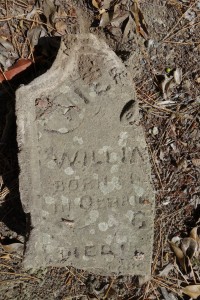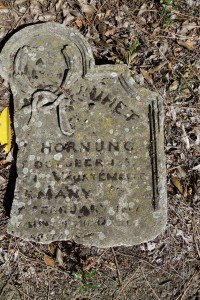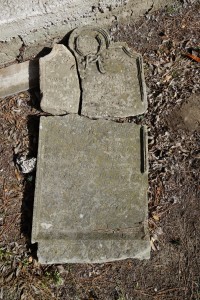Abraham Myers
Researcher: Matthew King
Abraham Myers was born in Prussia around 1830 and migrated to New Zealand prior to 1861, when he became a naturalised citizen. He married Johanna Ehrenfried in 1862 and they had five children. A jeweller and pawnbroker, Abraham was also involved in the development of the Jewish school and synagogue.
Abraham died age 63 on 29 April 1893, also listed on his gravestone as 14 Eer 5653. Situated in the Jewish section, the gravestone is on a steep bank, almost hidden away. It features Hebrew inscriptions now difficult to read due to the absence of lead lettering. This may be the result of erosion, along with a crack running through the stone. It may also be a result of vandalism to the Jewish section in 2015.
In the same plot is the headstone of his son Benjamin who died in Australia in 1891.
William Hornung
Researcher: Anton Sveding
William Hornung was a German migrant who was born on 21 October 1837 in the small town of Ochringen in Wurttemberg, Germany. In 1856, when Hornung was about 19 years of age, he migrated to New Zealand. His adventure was short lived, however, as after suffering from ill-health at Dunedin Hospital he died on 18 February 1864 at only 26 years of age. He was buried in the general section of Dunedin’s Southern Cemetery. Today there is no headstone marking his grave. Instead, it lies shattered in three pieces on the grave next to him. Despite fracturing and eroding with time, it is still possible to learn about Hornung by studying his gravestone.
Hornung’s German origins are obvious from the inscription of his birth at Ochringen and the engraving of ‘Hier Ruhet’ (German for ‘Here Rest’). These two words are separated by a laurel wreath which could represent two things. First, it could refer to his profession as Hornung was a butcher and one type of laurel is known as the Spineless butcher’s broom. Alternatively, it could convey a religious message as a laurel wreath also symbolises eternal life. This religious theme of eternal life continues with the passage from Matthew XXV inscribed on the stone which focuses on an everlasting life for the righteous. In summary, the gravestone represents three aspects of Hornung’s identity: his origins, profession and religious beliefs.






